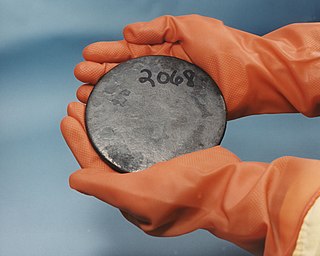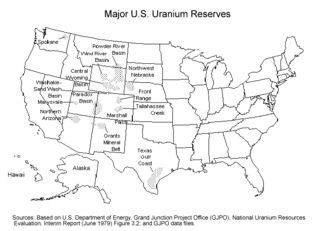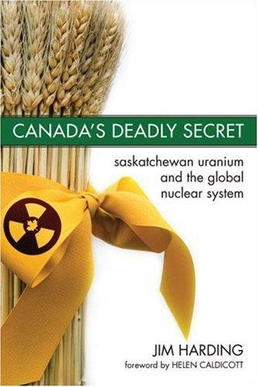Related Research Articles

Uranium is a chemical element with the symbol U and atomic number 92. It is a silvery-grey metal in the actinide series of the periodic table. A uranium atom has 92 protons and 92 electrons, of which 6 are valence electrons. Uranium radioactively decays, usually by emitting an alpha particle. The half-life of this decay varies between 159,200 and 4.5 billion years for different isotopes, making them useful for dating the age of the Earth. The most common isotopes in natural uranium are uranium-238 and uranium-235. Uranium has the highest atomic weight of the primordially occurring elements. Its density is about 70% higher than that of lead and slightly lower than that of gold or tungsten. It occurs naturally in low concentrations of a few parts per million in soil, rock and water, and is commercially extracted from uranium-bearing minerals such as uraninite.

Radioactive waste is a type of hazardous waste that contains radioactive material. It is a result of many activities, including nuclear medicine, nuclear research, nuclear power generation, nuclear decommissioning, rare-earth mining, and nuclear weapons reprocessing. The storage and disposal of radioactive waste is regulated by government agencies in order to protect human health and the environment.

Cameco Corporation is the world's largest publicly traded uranium company, based in Saskatoon, Saskatchewan, Canada. In 2015, it was the world's second largest uranium producer, accounting for 18% of world production.

Uranium mining is the process of extraction of uranium ore from the ground. Over 50,000 tons of uranium were produced in 2019. Kazakhstan, Canada, and Australia were the top three uranium producers, respectively, and together account for 68% of world production. Other countries producing more than 1,000 tons per year included Namibia, Niger, Russia, Uzbekistan and China. Nearly all of the world's mined uranium is used to power nuclear power plants. Historically uranium was also used in applications such as uranium glass or ferrouranium but those applications have declined due to the radioactivity and toxicity of uranium and are nowadays mostly supplied with a plentiful cheap supply of depleted uranium which is also used in uranium ammunition. In addition to being cheaper, depleted uranium is also less radioactive due to a lower content of short-lived 234
U and 235
U than natural uranium.
Uranium in the environment is a global health concern, and comes from both natural and man-made sources. Beyond naturally occurring uranium, mining, phosphates in agriculture, weapons manufacturing, and nuclear power are anthropogenic sources of uranium in the environment.

Uranium mining in the United States produced 224,331 pounds (101.8 tonnes) of U3O8 in 2023, 15% of the 2018 production of 1,447,945 pounds (656.8 tonnes) of U3O8. The 2023 production represents 0.4% of the uranium fuel requirements of the US's nuclear power reactors for the year. Production came from five in-situ leaching plants, four in Wyoming (Nichols Ranch ISR Project, Lance Project, Lost Creek Project, and Smith Ranch-Highland Operation) and one in Nebraska (Crowe Butte Operation); and from the White Mesa conventional mill in Utah.
Nuclear power is the fifth-largest source of electricity in India after coal, hydro, solar and wind. As of November 2024, India has 24 nuclear reactors in operation in 8 nuclear power plants, with a total installed capacity of 8,180 MW. Nuclear power produced a total of 48 TWh in 2023, contributing around 3% of total power generation in India. 11 more reactors are under construction with a combined generation capacity of 8,700 MW.

Nuclear weapons testing, uranium mining and export, and nuclear power have often been the subject of public debate in Australia, and the anti-nuclear movement in Australia has a long history. Its origins date back to the 1972–1973 debate over French nuclear testing in the Pacific and the 1976–1977 debate about uranium mining in Australia.
The Australian Uranium Association was an Australian industry trade group which represented companies involved in uranium exploration, mining and export. It operated from September 2006 until 2013, after which its responsibilities were absorbed by the Minerals Council of Australia.

Nuclear power in Australia has been a topic of debate since the 1930s. Australia has one nuclear reactor (OPAL) at Lucas Heights, New South Wales, which is only used to produce radionuclides for nuclear medicine, and does not produce electricity. Australia hosts 33% of the world's proven uranium deposits, and is currently the world's third largest producer of uranium after Kazakhstan and Canada.

Canada's Deadly Secret: Saskatchewan Uranium and the Global Nuclear System is a 2007 book by Jim Harding which chronicles the struggle over Saskatchewan's uranium mining, and demonstrates the negative impacts on Aboriginal rights and environmental health, and the effect of free trade. Harding argues that nuclear energy cannot mitigate global warming and that the "peaceful nuclear technology" does not exist. Helen Caldicott wrote the foreword to the book.

Atomredmetzoloto, JSC,, the Mining Division of Rosatom State Atomic Energy Corporation, is a Russian uranium producer internally ranked sixth in the world in terms of uranium production and second in terms of in-situ uranium reserves. ARMZ Uranium is the only uranium producer with operations inside Russia.

Radioactive ores were first extracted in South Australia at Radium Hill in 1906 and Mount Painter in 1911. 2,000 tons of ore were treated to recover radium for medical use. Several hundred kilograms of uranium were also produced for use in ceramic glazes.

The uranium mining debate covers the political and environmental controversies of uranium mining for use in either nuclear power or nuclear weapons.
Mardai is an abandoned uranium mining town located in the Dornod aimag of Mongolia, in a remote area north of Choibolsan.
The world's largest producer of uranium is Kazakhstan, which in 2019 produced 43% of the world's mining output. Canada was the next largest producer with a 13% share, followed by Australia with 12%. Uranium has been mined in every continent except Antarctica.

Mining is important to the national economy of Mongolia. Mongolia is one of the 29 resource-rich developing countries identified by the International Monetary Fund and exploration of copper and coal deposits are generating substantial additional revenue.
The World Uranium Hearing was held in Salzburg, Austria in September 1992.Anti-nuclear speakers from all continents, including indigenous speakers and scientists, testified to the health and environmental problems of uranium mining and processing, nuclear power, nuclear weapons, nuclear tests, and radioactive waste disposal.
References
- 1 2 "Uranium in Mongolia". World Nuclear Association. 29 April 2024. Retrieved 26 January 2025.